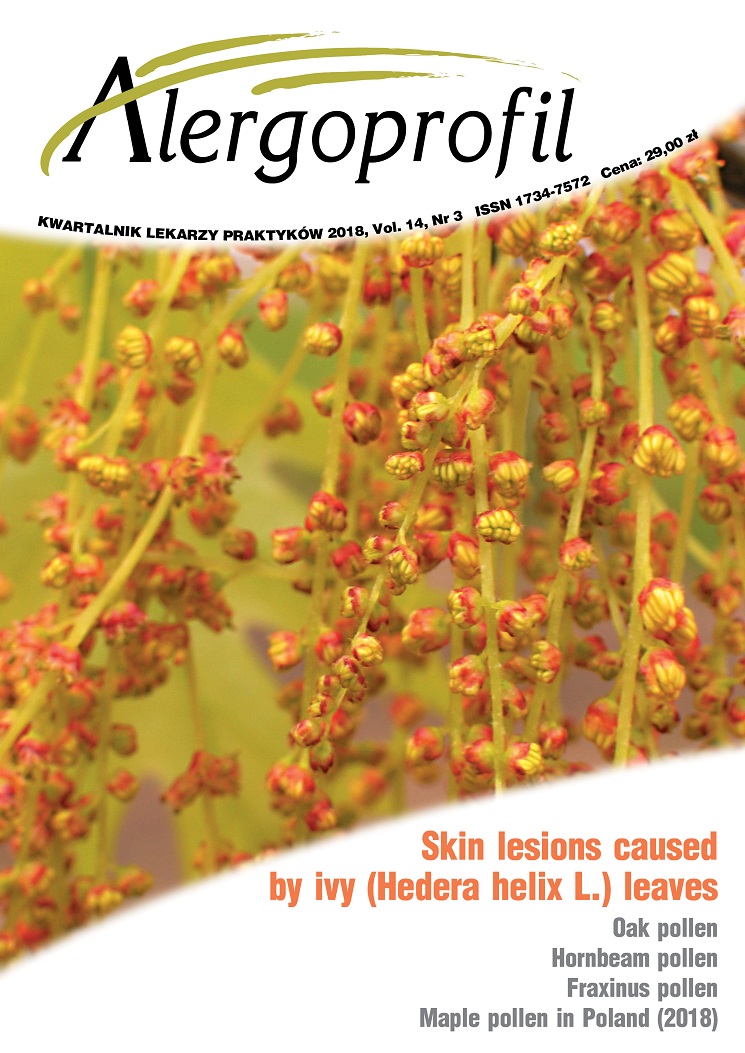Skin lesions caused by ivy (Hedera helix L.) leaves
Main Article Content
Abstract
Hedera helix leaves are a medicinal raw material with toxic properties related to the content of triterpene saponins. The rationale behind the anatomical analyses of ivy leaves conducted in the present study was a case of skin lesions triggered by contact with the plant while gardening and a need to find its cause. In microscopic studies, we have determined the location of secretory tissues and analysed their content with the use of histochemical assays. We have demonstrated that essential oil is produced by glandular trichomes and secretory channels located close to vascular bundles. We have found that the epidermis cell secretion, which can evoke reaction, is present not only in the trichomes but also on the surface of leaf blades and petioles.
Downloads
Article Details
Copyright: © Medical Education sp. z o.o. This is an Open Access article distributed under the terms of the Attribution-NonCommercial 4.0 International (CC BY-NC 4.0). License (https://creativecommons.org/licenses/by-nc/4.0/), allowing third parties to copy and redistribute the material in any medium or format and to remix, transform, and build upon the material, provided the original work is properly cited and states its license.
Address reprint requests to: Medical Education, Marcin Kuźma (marcin.kuzma@mededu.pl)
References
2. Broda B, Mowszowicz J. Przewodnik do oznaczania roślin leczniczych, trujących i użytkowych. Wydawnictwo Lekarskie PZWL, Warszawa 2000.
3. Podbielkowski Z, Sudnik-Wójcikowska B. Słownik roślin użytkowych. Państwowe Wydawnictwo Rolnicze i Leśne, Warszawa 2003.
4. Strzelecka H, Kowalski J. Encyklopedia zielarstwa iziołolecznictwa. Państwowe Wydawnictwo Naukowe, Warszawa 2000.
5. Hlava B, Starý F, Pospíšil F. Rośliny kosmetyczne. Państwowe Wydawnictwo Rolnicze i Leśne, Warszawa 1984.
6. Góra J, Lis A. Najcenniejsze olejki eteryczne. Wydawnictwo Uniwersytetu Mikołaja Kopernika, Toruń 2005.
7. Lipiński M. Pożytki pszczele. Zapylanie i miododajność roślin. Powszechne wydawnictwo Rolnicze i Leśne, Warszawa; Wyd. Sądecki Bartnik, Stróże 2010.
8. Lamer-Zarawska E, Kowal-Gierczak B, Niedworok J (ed). Fitoterapia i leki roślinne. Wydawnictwo Lekarskie PZWL, Warszawa 2012.
9. Kohlmünzer S. Farmakognozja. Podręcznik dla studentów farmacji. Wydawnictwo Lekarskie PZWL, Warszawa 2016.
10. Zohary M. Plants of the Bible. Cambridge University Press, Cambridge 1982.
11. Sadowska A (ed). Rakotwórcze i trujące substancje roślinne. Wyd. SGGW, Warszawa 2004.
12. Brinkmann H, Wißmeyer K, Gehrmann B et al. Fitoterapia. Racjonalne porady i zalecenia. MedPharm Polska, Wrocław 2007.
13. Podlech D. Rośliny lecznicze. Muza SA, Warszawa 1994.
14. Motta GB. Lecznicze rośliny Biblii. Tajemnice zdrowotne Pisma Świętego. Wyd. Esprit, Kraków 2016.
15. Jabłońska-Trypuć A, Czerpak R. Surowce kosmetyczne i ich składniki. Część teoretyczna i ćwiczenia laboratoryjne. MedPharm, Wrocław 2008.
16. Maurizio A, Grafl I. Das Trachtpflanzenbuch. Nektar und Pollen die wichtigsten Nahrungsquellen der Honigbiene. Eherenwirth Verlag, München 1969.
17. Perry LM. Medicinal Plants of East and Southeast Asia. Attributed Properties and Uses. The MIT Press, Cambridge, Massachusets and London 1985.
18. Gaillard Y, Blaise P, Darré A et al. An Unusual Case of Death: Suffocation Caused by Leaves of Common Ivy (Hedera helix). Detection of Hederacosine C, α-Hederin, and Hederagenin by LC-EI/MS-MS. J Anal Toxicol 2003, 27(4): 257- 262.
19. Bohne B, Dietze P. Rośliny trujące. Wydawnictwo Bellona, Warszawa 2008.
20. Weryszko-Chmielewska E, Chwil M, Wesołowski M et al. Rośliny wywołujące fotodermatozy. Alergoprofil 2014, 10(4): 22-26.
21. Weryszko-Chmielewska E, Chwil M. Localisation of furanocoumarins in the tissues and on the surface of shoots of Heracleum sosnowskyi. Botany 2017, 95(11): 1057-1070. DOI: 10.1139/cjb-2017-0043.
22. Jakubowicz O, Żaba C, Nowak G et al. Heracleum sosnowskyi Manden. Ann Agric Environ Med 2012, 19(2): 327-328.
23. Rzymski P, Klimaszyk P, Poniedziałek B. Invasive giant hogweeds in Poland: risk of burns among forestry workers and plant distribution. Burns 2015, 41(8): 1816-1822. DOI: 10.1016/j.burns.2015.06.007.
24. Śpiewak R. The substantial differences between photoallergic and phototoxic reactions. Ann Agric Environ Med 2012, 19(4): 888-889.
25. Alberts A, Mullen P. Psychoaktywne rośliny i grzyby. Wydawnictwo MUZA SA, Warszawa 2002.

